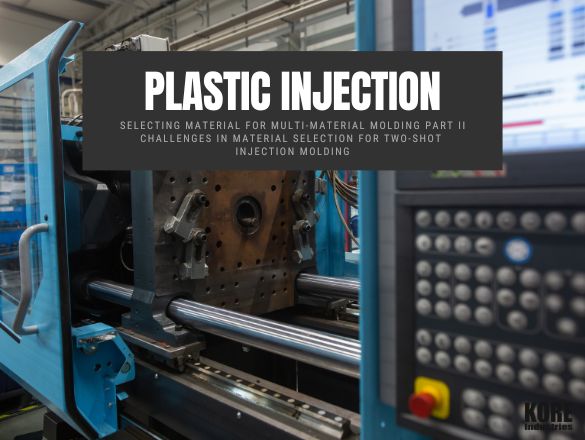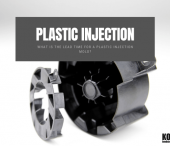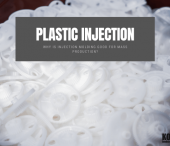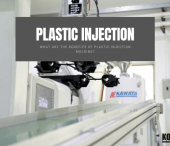Introduction
Multi-material molding, particularly two-shot injection molding, is a game-changer in the production of complex and diverse plastic components. As we delve deeper into the realm of material selection for multi-material molding in the second part of our series, the focus shifts to the unique challenges encountered in the context of two-shot injection molding.
What is two-shot injection molding?
Two-shot injection molding, multi-shot, double-shot, or two-K injection molding is a useful and versatile manufacturing procedure that conglomerates two or more different mediums into one or component. This groundbreaking technique has found uses in various industries, including packaging, automotive, and consumer electronics, among others.
The Two-Shot Injection Molding Process
The two-shot injection molding process involves the following steps:
- Mold Preparation: The mold is prepared for the first material, which will form the base or substrate for the second material.
- First Shot: The first material is injected into the mold, creating the base or substrate.
- Second Shot: After the first material has solidified, the second material is injected over or around the first, creating the final part or component.
Factors Influencing Material Selection
When selecting materials for blank molding injection keep the following in mind:
- Compatibility and Adhesion
Achieving smooth compatibility and cohesion between the two molding ingredients is a key challenge in two-shot injection molding. The mediums must bond correctly and solidly to make sure the structural integrity is reliable in the final part.
Choosing materials that bot adhere well to one another while maintaining this adhesion over the lifecycle of the product is crucial. Improper bonding will lead to reduced mechanical properties, delamination, and an overall compromised part.
- Differential Shrinkage
Differential shrinkage is a process many of us struggle with. There is nothing worse than shrinkage ruining a two-shot injection molding as the two materials may cool down and conglomerate at different rates. These uneven fits lead to warping, dimensional inaccuracies, or distortion in the molded component. To get past this challenge requires a deep knowledge of the shrinkage process of each material, chemical and adjustments in mold design along with process parameters to achieve the right fit.
- Melt Compatibility
Surprisingly, melt compatibility is critical in making two-shot injection molding processes successful. These materials need to blend evenly during the injection procedure, avoiding issues like inconsistent mixing or phase separation. Selecting materials with comparable melting points and rheological characteristics is essential to a uniform chemical merger, preventing undesirable results in the injection process.
- Surface Adhesion
Making sure proper that surface adhesion between the two shots is adequate can be a challenge. Without a strong bond, the two materials can separate, leading to structural weaknesses in the final part. Techniques like surface preparation and cautious medium selection are important in overcoming this challenge to make sure bond is strong and lasting.
- Material Cost
With Two-shot injection molding material costs is often higher when compared to traditional injection molding. This means that selecting materials, balancing between getting the desired characteristics and keeping costs low is a critical. Making the process cost-effective by choosing the right material in terms of performance requirements is important for the project economic viability of two-shot molding jobs.
Overcoming Challenges: A Meticulous Approach
To deal with issues of material cost, surface adhesion in material selection for two-shot injection molding requires meticulous and informed approach. Here are policies to navigate these challenges and get successful outcomes:
- Comprehensive Material Analysis
Directing a thorough analysis of the thermal, mechanical, and rheological features of each medium is paramount. This examination helps classify potential synchronization issues and guides the selection of ingredients with matching characteristics. Companies should cooperate with material suppliers to advance insights into the performance of different mediums in a two-shot injection molding process.
- Prototype Testing
Prototyping lets manufactures evaluates materials for compatibility and long lasting performance in working conditions. The process of Iterative testing with prototypes refines material decisions on materials and optimizes two-shot injection molding. Fooling this stage lets manufacturers identify and address issues early in the expansion cycle, lowering the possibilities issues in full-scale production.
- Collaboration and Expertise
Engaging in a beneficial partnership with material providers and leveraging the knowledge of professionals with a background in two-shot injection molding is priceless. Knowledgeable medium suppliers provide insights into the compatibility of distinct materials and suggests ideas based on their experience. This collaboration with experts ensures informed decision-making process and they will listen when you mention your particular frustrating issues.
- Advanced Simulation Tools
Utilizing advanced simulation tools can simulate the two-shot injection molding process, allowing manufacturers to anticipate challenges such as shrinkage, adhesion issues, and material behavior. This proactive approach aids in optimizing material selection and process parameters before moving to full-scale production. Simulation tools provide a virtual environment to test different material combinations and assess their impact on the final part.
- Continuous Improvement
Practice makes perfect and Two-shot injection molding as an evolving field is no different. Continuous improvement is key to finding out what works and overcoming challenges. Manufacturers and fabricators have to be informed about processing technologies, industry advancements in materials, and best practices. By learning from project iteration and incorporating those insights into future attempts ensures a refinement of material selection and outcomes.
Challenges in Material Selection and key points
So considering the information above what have we learned?
Differential Shrinkage: Think about material shrinking through cooling for design changes.
Melt Compatibility: Incompatible melt characteristics cause flow issues and uneven material distribution.
Surface Adhesion: Proper adhesion is important. Surface processing procedure are often required.
Material Cost: Equilibrium between material cost and performance requirements.
Strategies for Successful Material Selection
Collaboration with Material Suppliers: Check with your material suppliers for suitability and performance direction.
Mold Design Optimization: Account for disparity shrinkage and irregular material delivery in mold designs for complex geometries.
Prototyping and Testing: institute prototyping and testing stages to sort out a mixture’s material performance in real-life conditions. Iterate as required to get optimal results.
Data-Driven Decision-Making: Apply data and simulation tools to plan for material behavior during molding and life expectancy of a tool.
Pay Attention to Regulatory Standards: For heavily regulated industries such as the medical or automotive fields, choose materials that are compliant with industry standards.
Selecting Multi-Material Injection Molding Is Complex
Finding materials for multi-material injection molding requires close scrutiny. A successful molding project hinges on thorough medium understanding. Molding experts create groundbreaking products fusing several materials through design, partnerships, and testing.
Summary
Also known as double-shot molding, this novel manufacturing procedure is a gateway to improved dynamic part performance, efficient assembly processes, and higher product aesthetics. So today, let us enlighten you as we delve into the lively and creative landscape of two-shot injection molding and reveal strategies for crafting valuable utensils, particularly in arenas such as medical, manufacturing, packaging, and automotive equipment.
Unveiling Two-Shot Injection Molding
Two-shot injection molding, otherwise called by some as multi-shot, double-shot, or two-K injection molding, is a adaptable manufacturing procedure that merges two or more dissimilar mediums into a single, unified component.
This groundbreaking method has found uses in many industries, like medical equipment and consumer electronics. Some specific example of two-shot Injection molding in packaging and automotive parts production include built-in seals, grips, or color variations, such as closures for bottles and containers.
Navigating the Two-Shot Injection Molding Process
The process involves meticulous steps:
Mold Preparation: The mold is prepared for the first material to be injected; this creates the base for the second medium. Once the first material is injected into the mold it forms the substrate ansd helps strengthen the construction and mold as a whole. After solidification of the first material and the total substrate, the secondary material is then injected over or around it, coagulating culminating into a strong and reliable final part or component.
Factors Shaping Material Selection
Choosing the materials for you two-shot injection molding project means taking careful consideration in:
- Compatibility and Adhesion: making sure there is a seamless compatibility and unity between the molding ingredients.
- Differential Shrinkage: Taking the time to address the issue of differential shrinkage mean knowing the unique characteristics of each material that causes shrinkage.
- Melt Compatibility: Melt compatibility is surprisingly critical as it ensures a uniform mix during the injection process, reducing issues such as inconsistent mixing or separation.
- Surface Adhesion: Ensuring proper surface bonding between the two shots can be callening and require preparation.
- Material Cost: considering the cost of two-shot injection molding versus traditional injection molding is important.
A Strategic Approach to Overcoming Challenges
Addressing medium cost and surface adhesion issues requires a careful and informed approach. Here are methods for the best outcomes:
- Comprehensive Material Analysis: Implementing a thorough examination of mechanical, thermal, and rheological characteristics of each medium is important.
- Prototype Testing: Prototyping lets fabricators evaluate ingredients for compatibility and long-term performance in real-world working conditions.
- Collaboration and Expertise: work with experts ensures an knowledgeable decision-making process.
- Advanced Simulation Tools: Using advanced simulation tools assists manufacturers expect challenges, enhancing material selection and procedure parameters prior to full-scale production.
- Continuous Improvement: Staying knowledgeable about production technologies, industry developments, and best practices makes sure a refinement of material selection steps.
Key Takeaways
Differential Shrinkage: Consider the medium shrinking during cool down process for design adjustments.
Melt Compatibility: Incompatible melt properties cause flow problems and uneven medium distribution.
Surface Adhesion: Proper adhesion is important. Surface preparation procedures are often needed.
Material Cost: Striking a balance concerning material cost vs performance requirements is essential.
Strategies for Successful Material Selection
To make sure you have selected the right material for two-shot injection molding, think about the following:
Collaboration with Material Suppliers: Reach out to material suppliers for fitness and performance management.
Mold Design Optimization: Account for difference shrinkage and unequal material delivery in mold conception for complex geometries.
Prototyping and Testing: Implement prototyping and testing phases in order to assess material function in real-world conditions. Iterate as need for the best results.
Data-Driven Decision-Making: Apply data and simulation utensils to plan for medium behavior during molding and the course of the tool's life expectancy.
Regulatory Standards: When dealing with heavily regulated industries, select materials that comply with industry criteria.





